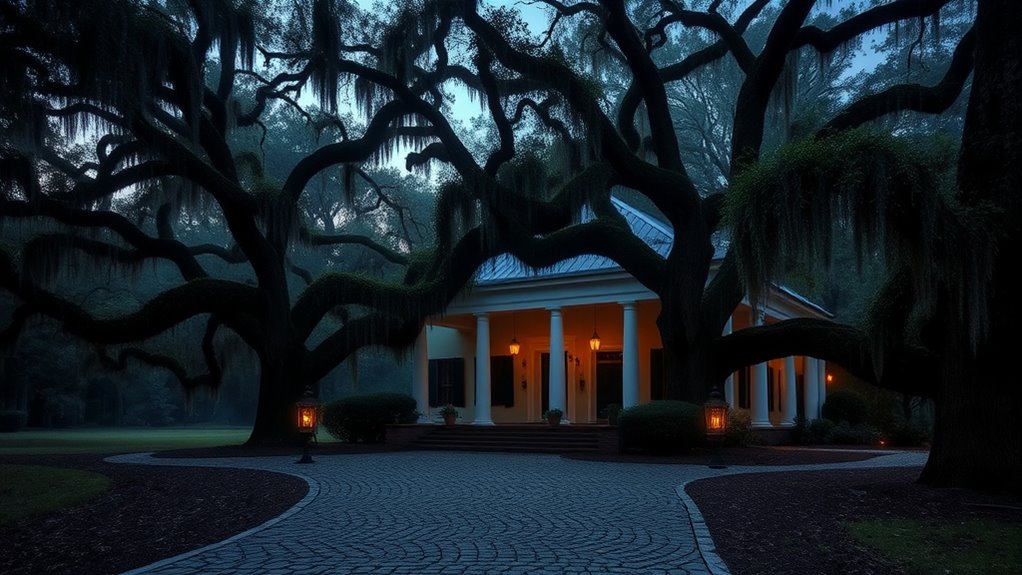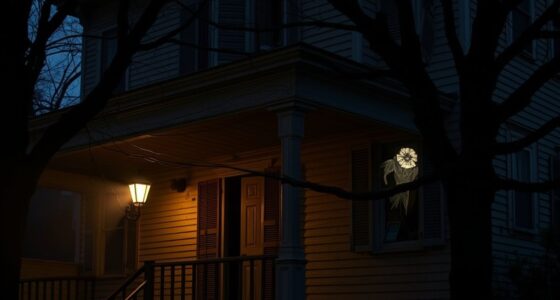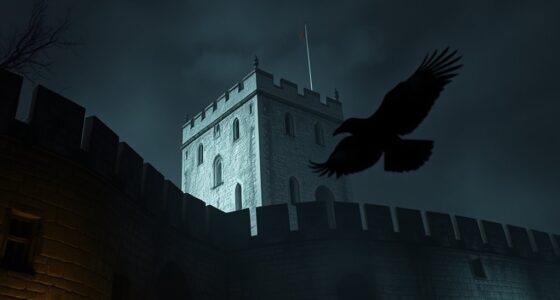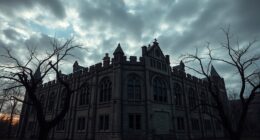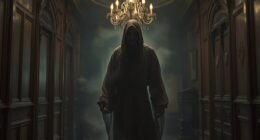The Myrtles Plantation in St. Francisville, Louisiana, captivates visitors with its haunting tales and tragic history. Originally built in 1796, the plantation is said to house playful spirits and ghostly figures, like the infamous Chloe. You’ll hear eerie sounds, spot mysterious handprints on mirrors, and even witness unexplained phenomena. Each corner holds a story, creating a perfect blend of history and mystery that invites you to discover more about its spectral inhabitants and their past.
Key Takeaways
- The Myrtles Plantation, built in 1796, is known for its Creole cottage architecture and rich cultural heritage.
- Reports of ghostly encounters include sightings of a girl named Kate Winter and playful children’s laughter.
- The plantation is believed to be situated atop an Indian burial ground, adding to its haunted reputation.
- A persistent blood stain appears in a doorway, defying cleaning attempts, enhancing the plantation’s eerie lore.
- The tragic story of Chloe, a former slave, is central to the haunting narratives and visitor experiences at the plantation.
Location and Historical Significance
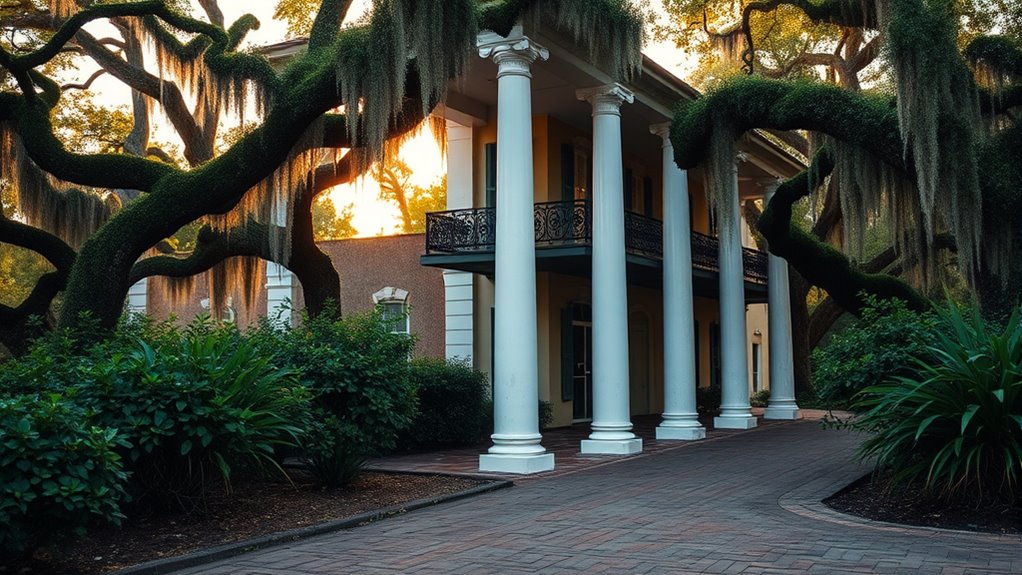
Nestled in the heart of West Feliciana Parish, Myrtles Plantation is located at 7747 U.S. Hwy. 61, St. Francisville, LA 70775.
This remarkable site spans approximately 10 acres and showcases a beautiful example of Creole cottage architecture. Built by General David Bradford in 1796, this plantation carries significant historical weight and was added to the National Register of Historic Places in 1978.
While exploring, you’ll appreciate the rich cultural heritage of St. Francisville and the stories of those who worked the land, including enslaved people. A visit here is more than just a tour; it’s a journey into Louisiana’s past, making it a must-see for history enthusiasts.
Don’t forget to bring a car for easy access!
Ownership Through the Ages
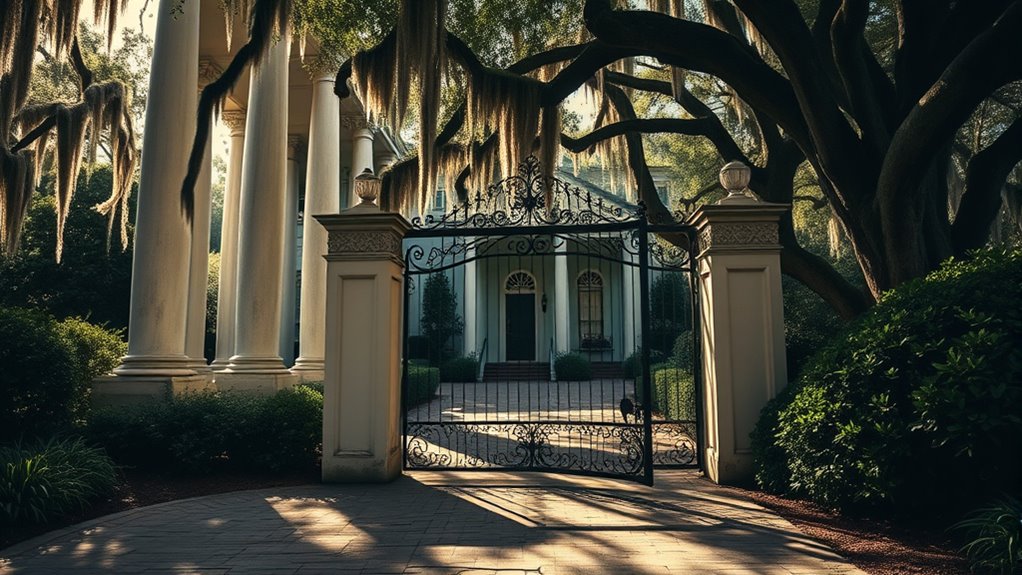
The history of Myrtles Plantation is marked by a series of ownership changes that reflect the changing tides of American society.
Originally built by General David Bradford in 1796 as “Laurel Grove,” it shifted to Elizabeth Bradford after his death in 1808.
Originally constructed as “Laurel Grove” by General David Bradford in 1796, it was inherited by Elizabeth Bradford following his passing in 1808.
In 1817, Clarke Woodruff took over management. The plantation was then sold to Ruffin Gray Stirling in 1834, who expanded it greatly, renaming it “The Myrtles.”
After Stirling’s death in 1854, the property changed hands several times, passing to Mary Cobb Stirling, then Oran D. Brooks, and Harrison Milton Williams.
In the 1950s, Marjorie Munson bought it, leading to reports of paranormal activity.
Today, the Moss family owns it, continuing its legacy as a bed and breakfast.
Ghostly Manifestations and Encounters
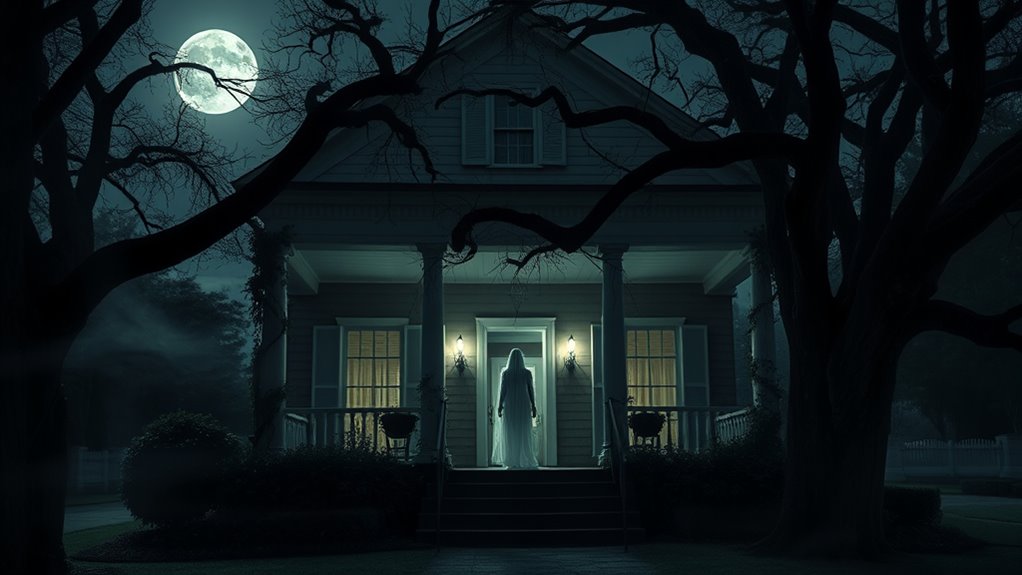
As you step onto the grounds of Myrtles Plantation, you might feel an eerie presence that hints at the countless ghostly encounters reported by visitors over the decades.
Transparent figures often appear, including a girl resembling Kate Winter, who succumbed to yellow fever. You may hear the sounds of children giggling, a sign of the playful spirits lingering in the air.
Many have captured photographic evidence of these apparitions, while others report physical encounters, like clothes being pulled or gentle tickling by unseen hands.
The main staircase, where Mr. Winters’ footsteps echo, and the card room, known for ghostly child portraits, are hotspots for paranormal activity.
Each visit here offers a chance to connect with the plantation’s haunted history.
Notable Legends and Lore
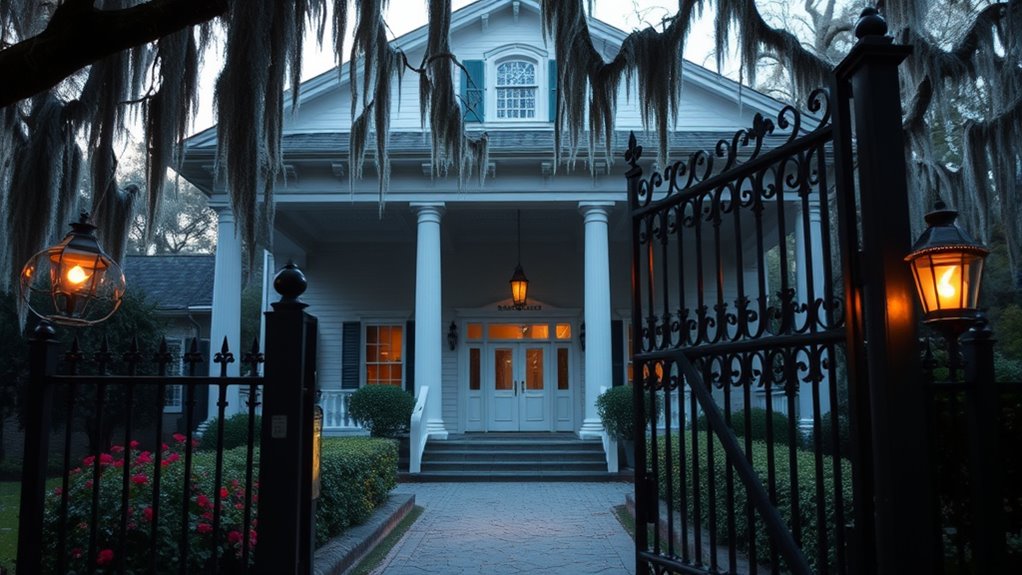
While exploring the haunted grounds of Myrtles Plantation, you’ll encounter a rich tapestry of legends and lore that have transcended generations.
Many believe the plantation sits atop an Indian burial ground, leading to sightings of a young Native American woman’s ghost. The echoes of the Civil War resonate here, with tales of Union soldiers ransacked and three lives taken inside.
You’ll notice an unyielding blood stain in a doorway, despite countless cleaning attempts. Mirrors in the house are said to hold the spirits of Sara Woodruff and her children, their handprints often appearing.
As you wander, you might hear ghostly footsteps, catch whiffs of mysterious smells, or witness objects inexplicably vanish and reappear, adding to Myrtles’ enigmatic charm.
The Story of Chloe
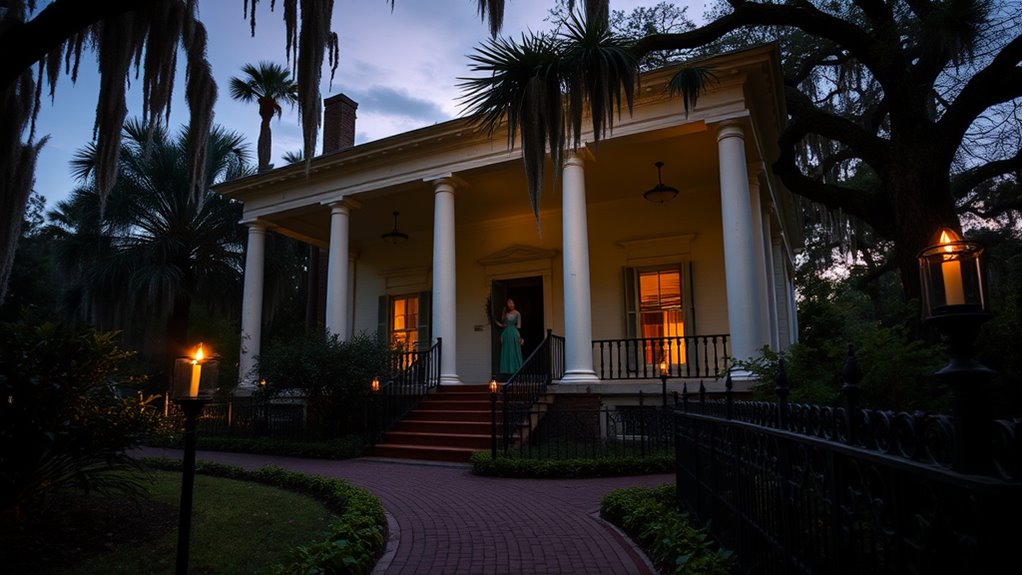
Chloe’s haunting tale remains a central piece of Myrtles Plantation’s lore, enchanting visitors with its blend of tragedy and ghostly intrigue.
As a governess to the Woodruff children, Chloe navigated a complex relationship with Judge Woodruff, marked by coercion and fear. Her desire to secure her place in the household led her to a tragic decision to poison the family with oleander, intending to cause illness but resulting in the deaths of two children.
This event sparked her demise at the hands of fellow slaves, fearing repercussions. Today, Chloe’s ghost, often seen wearing a green turban, symbolizes her pain and the harsh realities of her life, mesmerizing those who visit the haunted plantation.
Family Tragedies and Their Impact
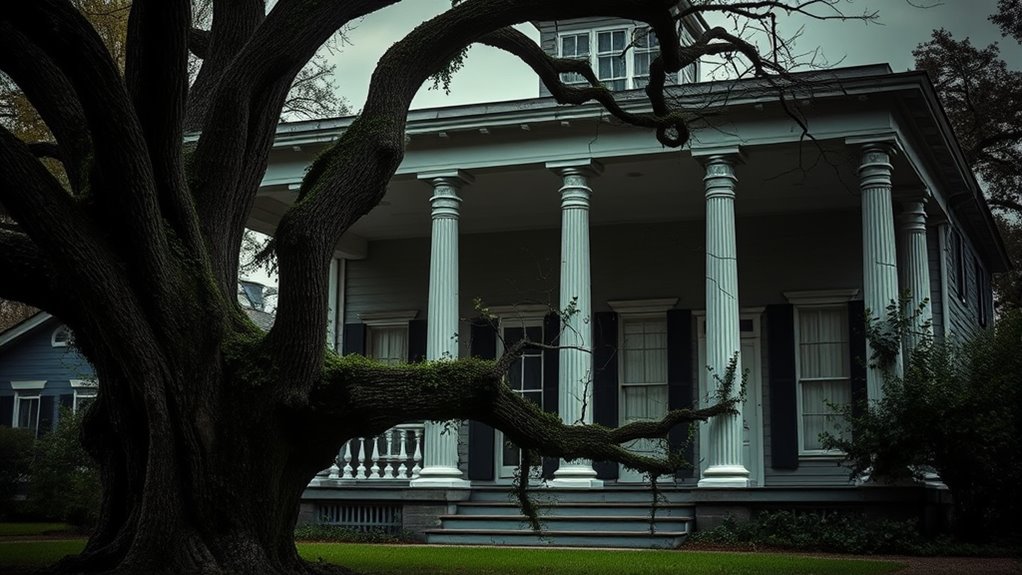
Family tragedies at Myrtles Plantation have left an indelible mark on its history, shaping not only the lives of those who lived there but also influencing the eerie atmosphere that surrounds it today.
The deaths of Sarah Matilda Woodruff and her children from yellow fever, along with Ruffin Stirling’s battle with tuberculosis, created a somber legacy. You can feel the weight of loss in the air, as numerous families faced devastating tragedies, including violent incidents and illnesses.
Visitors often report ghostly children playing, heavy footsteps, and unsettling feelings, all attributed to these past sorrows. The accumulation of untimely deaths and suffering has contributed to Myrtles’ haunted reputation, making it a place where the echoes of the past linger.
Historical Context and Misinterpretations
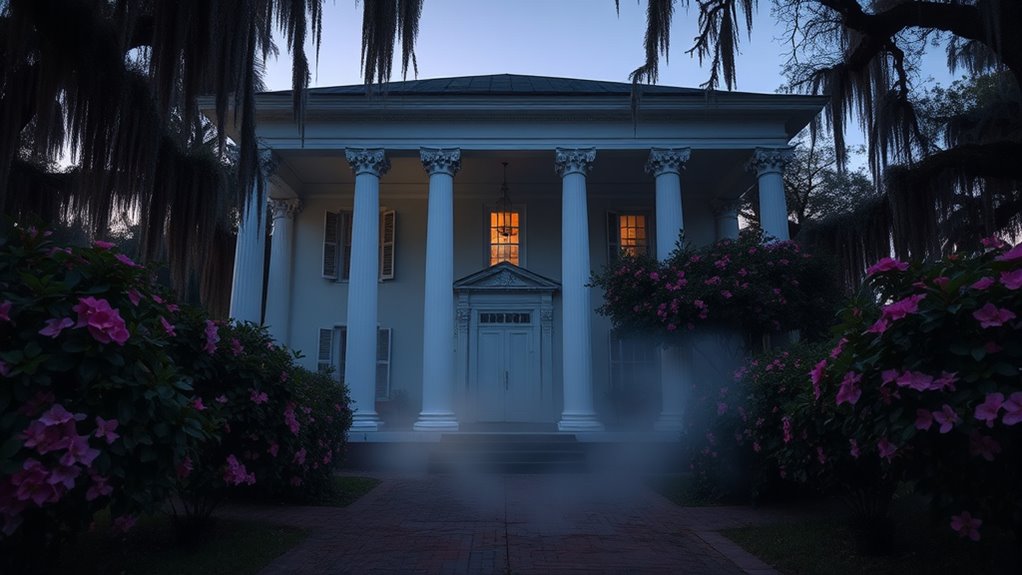
Despite its storied past, the historical context of Myrtles Plantation is often clouded by misinterpretations and myths that have taken root over the years.
The rich history of Myrtles Plantation is often overshadowed by myths and misinterpretations that mislead visitors.
You might hear exaggerated tales of hauntings and murders, but many of these claims lack solid evidence. For instance, while the murder of William Winter is well-documented, reports of multiple killings are often overstated.
Legends surrounding the plantation, fueled by local lore, can mislead visitors seeking the truth. The original structure, built in 1794 by David Bradford, served primarily as a cotton and indigo plantation, not a ghostly site.
As you explore, remember that the allure of Myrtles lies in its rich history, not solely in its haunting reputation.
Theories Behind the Haunting
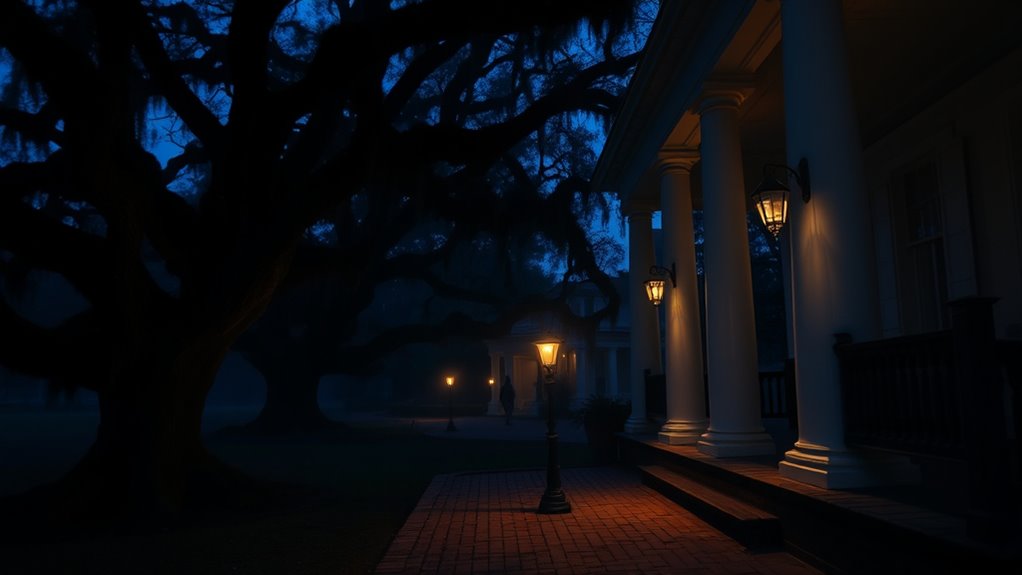
While many visitors come to Myrtles Plantation enthusiastic to encounter its ghostly legends, understanding the theories behind the hauntings reveals a complex interplay of history, tragedy, and psychology.
The tragic tale of Chloe, a slave punished by Clark Woodruff, sparks theories that link her suffering to the plantation’s hauntings. Events like the yellow fever epidemics and the murder of William Winter deepen the eerie atmosphere.
Visitors often experience psychological factors, such as confirmation bias and emotional connections, that fuel their belief in supernatural encounters. Additionally, scientific explanations suggest that natural phenomena or structural issues could mislead perceptions.
Ultimately, these elements combine to create a haunting narrative that captivates the imagination and invites exploration.
The Economic Impact of Paranormal Tourism
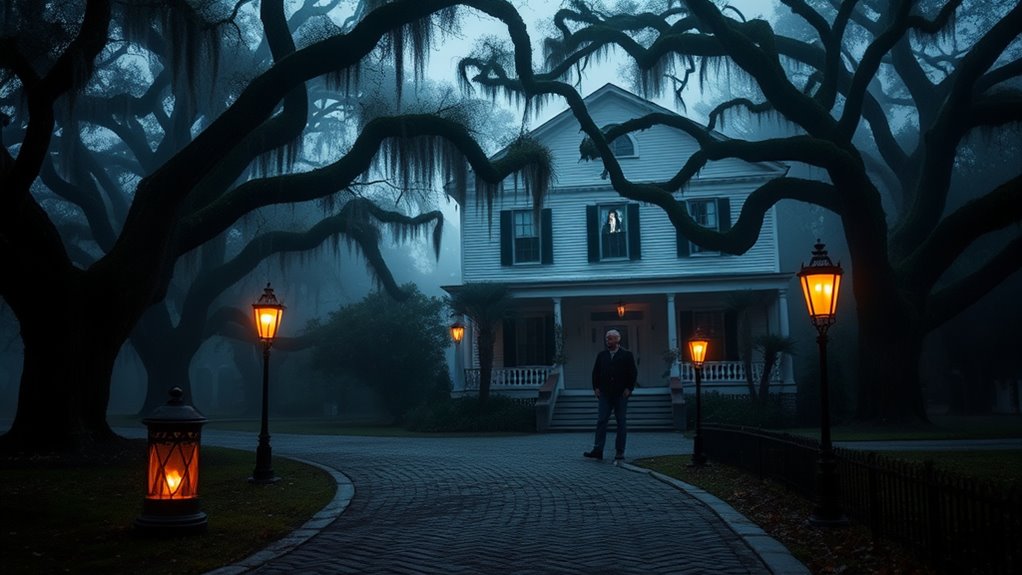
Myrtles Plantation’s ghostly legends not only intrigue visitors but also considerably boost the local economy through paranormal tourism.
This niche market draws tourists, increasing hotel bookings and local business revenues. You’ll find specialized jobs emerging in guided tours and hospitality, creating unique employment opportunities.
As visitors flock for ghost tours and events, spending on paranormal tourism can make up to 20% of local revenues, especially during the Halloween season. Entrepreneurs thrive by offering paranormal-themed attractions, supporting small businesses in the area.
Additionally, this interest in the supernatural encourages the preservation of historical sites like Myrtles, ensuring that the local culture and heritage remain vibrant.
Frequently Asked Questions
Can I Stay Overnight at Myrtles Plantation?
Yes, you can stay overnight at Myrtles Plantation!
You’ll find a variety of accommodations, from historic rooms in the main house to cozy garden cabins.
It’s best to book well in advance since rooms fill up quickly.
Make sure to check their website for availability and photos of the spaces.
Enjoy a unique experience, and don’t forget to explore the dining options and tours during your stay!
Is There a Fee for Visiting Myrtles Plantation?
When you step into the enchanting world of Myrtles Plantation, you’ll find that exploring its rich history comes with a modest fee.
Guided historical tours typically cost $15 per person, lasting about 45 minutes. If you choose to stay overnight, you’ll enjoy complimentary access to this intriguing tour.
For a more mysterious experience, consider joining the evening tours that explore the paranormal, adding an extra layer to your visit.
Are Guided Tours Available at the Plantation?
Yes, guided tours are available at the plantation.
You can choose from various options, including daytime historical tours and evening mystery tours. Each tour lasts between 45 minutes to an hour, led by knowledgeable guides who share fascinating insights into the plantation’s history and architecture.
Whether you prefer a private tour for a more personalized experience or a group setting, there’s something that’ll suit your interests perfectly.
What Safety Measures Are in Place for Visitors?
You might worry about safety while exploring, but rest assured, there are measures in place to protect you.
The staff is attentive, ready to assist with any concerns, and they actively manage the environment. They’ve implemented precautions against falling objects and provide bug spray to guarantee your comfort.
Plus, guided tours are conducted by experienced guides who keep you informed about any potential hazards, enhancing your visit without compromising your safety.
Enjoy your experience!
Can I Photograph the Plantation During My Visit?
Yes, you can photograph the plantation during your visit.
You’ll find that it’s a popular spot for various types of photography, including portraits and architectural shots.
Just be mindful of the general rules during guided tours, as there may be restrictions on where and when you can take photos.
Also, respect the property and its historical artifacts while capturing the beautiful surroundings.
Enjoy your photography session!
Conclusion
To sum up, the Myrtles Plantation isn’t just a historic site; it’s a hotspot for paranormal activity that draws thousands each year. Did you know that over 25,000 visitors flock to this haunted location annually? This statistic highlights how the allure of ghostly tales and tragic histories can greatly boost local economies, turning a once-forgotten plantation into a thriving tourist destination. So, whether you believe in ghosts or not, the Myrtles offers an enchanting glimpse into the past.
